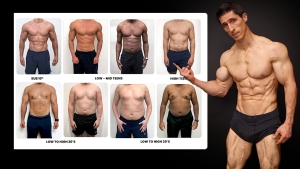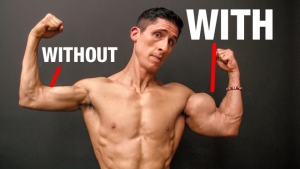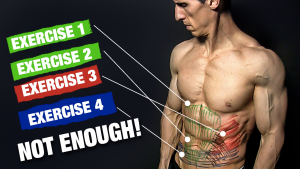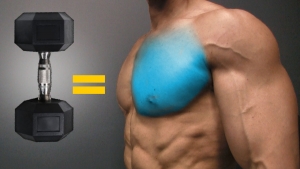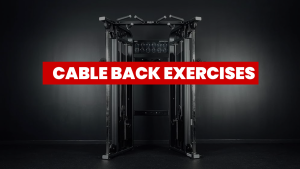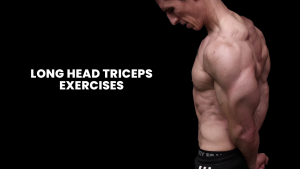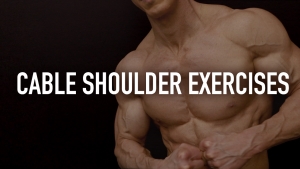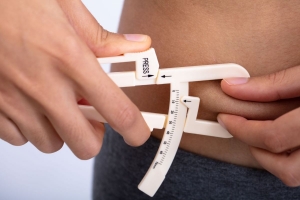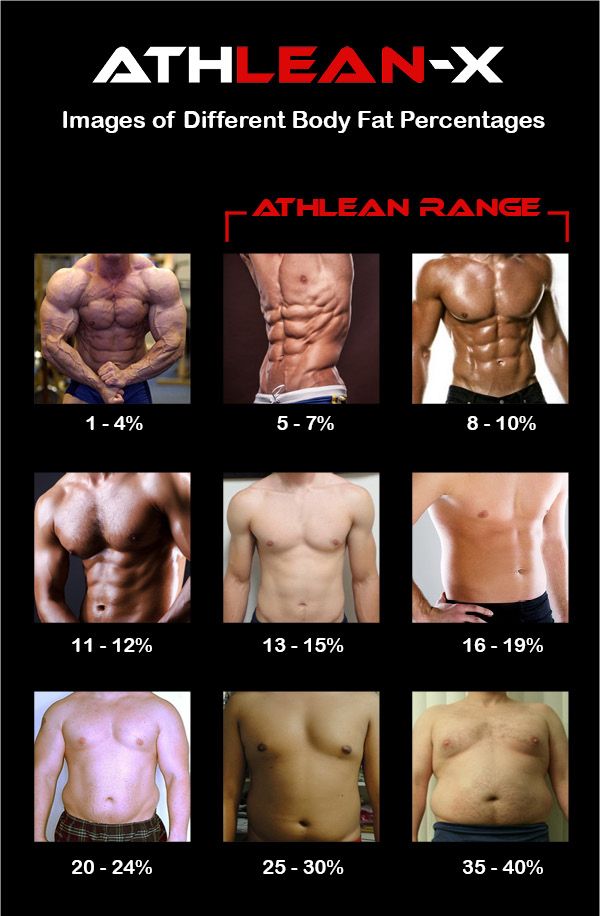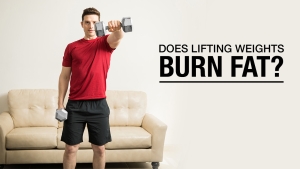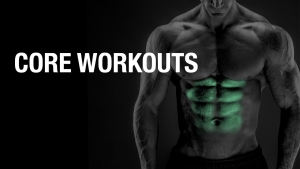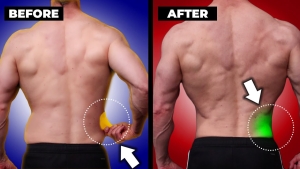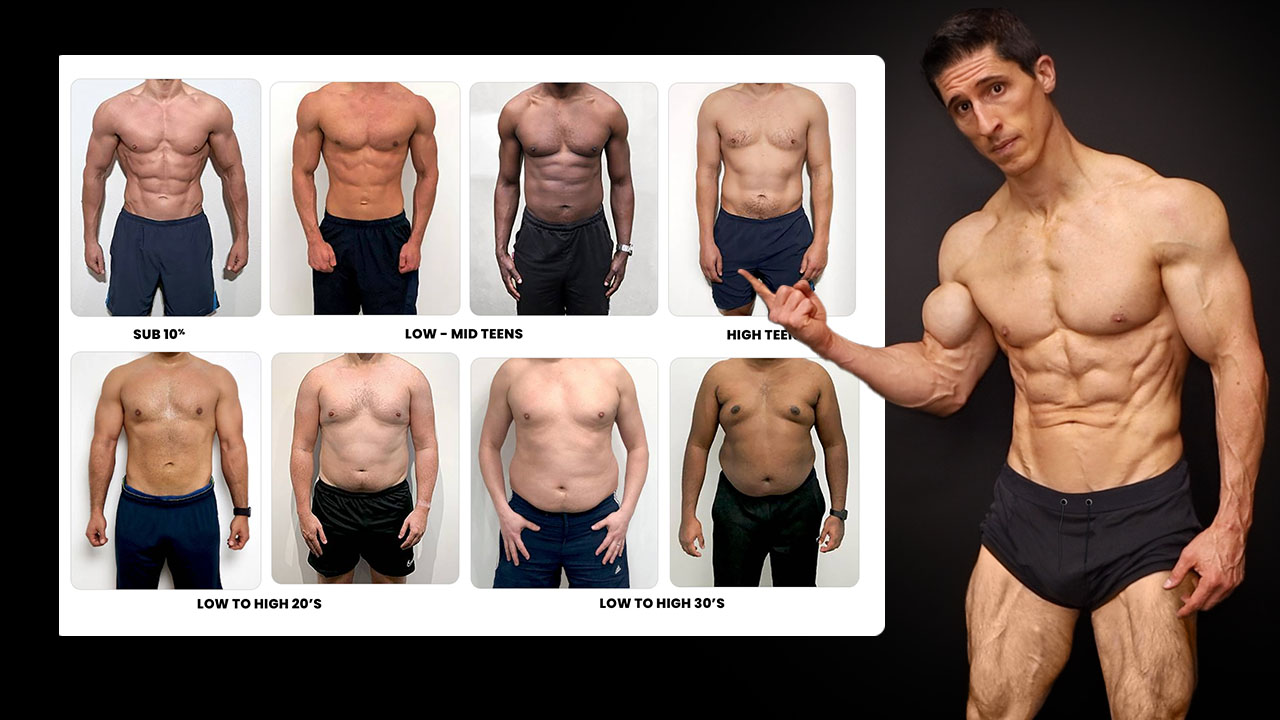
BODY FAT PERCENTAGE MEN – COMPLETE GUIDE
In my opinion, body fat percentage is the best, most accurate way for people to measure their progress on a strength training plan.
By now you probably know that I’m all about setting goals, and more importantly, having concrete ways to measure those goals. After all, having a goal is a prerequisite to actually getting somewhere…
Otherwise you’re just going through the motions and getting nowhere!
One of the biggest problems men face when they’re trying to start or stick to a fitness plan is that their goals are too big, or are just not clearly defined. If “I want to be ripped” is your goal, that’s great, but how do you measure that?
If we don’t have a clear idea of where we want to go with our fitness goals, it’s tough to set a plan for success and even tougher to stay motivated.
For those guys that know they want to get as strong and lean as possible, body fat percentage can be a key measurement of success.
HOW to MEASURE BODY FAT PERCENTAGE
There are tons of techniques to measure body fat percentage…some of them pretty expensive and most of them inaccurate.
Let’s take a look at a few techniques and their pros and cons:
WAYS TO MEASURE BODY FAT
- Online body fat calculator – Body fat calculators try to calculate your body fat based on age, height in inches, body weight and activity level using a statistical estimation method. Ignore these, because they’re very inaccurate. They don’t account for many different factors, including how much lean muscle mass you’ve got on your frame.
- Skin calipers – Known as a skinfold method, skinfold calipers estimate your body fat by having you pinch your fat in a couple of different places on the body. Unfortunately, cheap skin calipers can get varied results on the skinfold measurements based on user error. In fact, it’s common to get a different body fat percentage when two different ‘testers’ take the same skinfold measurements on the same body. There are more accurate skinfold calipers like Skyndex, which I use myself. However good ones are several hundred dollars, so the skinfold method can be cost prohibitive.
- Bioelectric impedance – There are two main types of bioelectrical impedance analysis devices: one that you hold in your hands and the body fat scales that you’re probably most familiar with. These send out a low level electrical signal into a foot or hand and measure how long it takes the signal to travel to the other foot or hand. Fat will slow down this electrical signal, while muscle, being a depot for water, will speed it up. Bioelectric impedance measurements can be inaccurate because lots of factors may impact the signal as it travels through the body. This could include callouses or how you hold or stand on the device.
- Hydrostatic weighing – Hydrostatic weighing estimates body fat by measuring your weight on land and in the water. Fat weighs less than bone and muscle, so if your underwater weight is heavier, you have a lower body fat percentage. This is one of the most accurate methods of calculating body fat percentage, however it can be expensive and may only be offered by a skilled professional at hospitals, universities and sports organizations. Underwater weighing is considered the gold-standard method for body fat measurement.
- DEXA scanning – DEXA stands for dual energy xray absorptiometry. In this body fat measurement process, you receive an x-ray scan that evaluates bone mass, lean body mass and fat mass throughout different areas of the body. It’s not quite as accurate as hydrostatic weighing for measuring body fat, and it can also be costly.
It’s also worth mentioning that you might get a wide variety of body fat percentage results from one method to the next, which can be pretty confusing!
There’s one more way to get an estimation of body fat percentage, which is relying on the eyes! It might be just as reliable of some of the other less expensive methods, but it won’t cost you at all!
HOW to MEASURE BODY FAT PERCENTAGE
I wanted you to have a way of determining your body fat level if you don’t have a caliper at home and don’t want to shell out for one of the more expensive methods.
That’s why I’ve put together this series of images to show what different body fat percentages look like.
Hopefully these photos will help you be able to identify where you’re at, and how much work you have ahead of you.
It’s important to keep in mind that not everybody stores fat the same way, so two bodies with the exact same body fat percentage could look pretty different. Fat distribution in men also changes as we age.
HOW TO DETERMINE YOUR BODY FAT PERCENTAGE
Below is a guide to help you figure out what your current body fat percentage is, what percent body fat to shoot for and what it may take to get there.
It’s important to remember that lowering your body fat percentage is definitely possible, but you must combine the right nutrition and training principles consistently over time to achieve it.
BODY FAT PERCENTAGE: 1-4%
This single-digit body fat percentage is one that’s most often targeted by professional bodybuilders for competition.
This is a very level of body fat and is tough even for pro bodybuilders to sustain, so this isn’t a recommended target range for most guys.
Typically in someone with body fat this low, the muscles are so well defined that the body could be used as a visual in an anatomy class!
When someone is below 5% body fat, not only will you see the separation of the muscles, but you will also clearly see the striations and extreme vascularity (prominent veins).
BODY FAT PERCENTAGE: 5-7% (ATHLEAN RANGE)
The 5-7% body fat range is a little more than a bodybuilder has in competition, and it’s more accessible for a lot of guys.
That being said, to maintain this body fat percentage, it’s going to require a strong dedication and to both fitness and nutrition and a lot of hard work!
Notice that in this range, the muscles are still very well defined and there is still some vascularity, but the striations aren’t as present as they are at 1-4%. The 5-7% body fat range is achieved by many fitness models in preparation for photo shoots.
BODY FAT PERCENTAGE: 8-10% (ATHLEAN RANGE)
The 8-10% body fat range is a good target range for many guys because it’s more sustainable.
It’s seen as a ‘healthy’ look by many and associated with the classic beach body. At 8-10%, vascularity and striations are less present, but still there in some parts of the body.
The abdominal muscles are visible, and you should be able to clearly see all three rows of abs. Some men may prefer to remain in this range for a bit less vascularity and a ‘smoother’ look.
BODY FAT PERCENTAGE: 11-12%
In this range, you may see some abdominal definition if, for example, you want to oil yourself up and shine a bright light at yourself like this guy did.
But who wants to walk around all slimy all the time?
BODY FAT PERCENTAGE: 13-15%
In this range, a guy may look pretty lean, but you just can’t quite see the abs yet.
Muscle definition in the rest of the body will also be slightly less visible.
BODY FAT PERCENTAGE: 16-19%
This body fat range doesn’t look ‘unhealthy’, but there will be less definition in the abdominal muscles.
At this range, depending on the guy you may start to see some love handles. There is some muscle definition in some areas, but it’s far less present than in the lower ranges. No vascularity will be noticeable.
BODY FAT PERCENTAGE: 20-24%
At 20% body fat, muscle definition starts to disappear and you can start seeing some hanging belly fat.
Vascularity and striation are not present, but the overall look doesn’t give the impression that the person is that badly out of shape. The average guy probably falls somewhere in the 20 – 24% body fat range.
BODY FAT PERCENTAGE: 25-30%
25% is the marker for obesity in men.
Beyond this point, muscle definition is probably not present, and the higher we go the more ‘round’ the person looks. Keep in mind that some guys can actually be quite muscular and ‘huge’ at 25%, but it isn’t accompanied by much definition.
BODY FAT PERCENTAGE: 35-40%
This range is considered ‘morbidly obese’ and little to no muscle definition will be visible.
As I eluded to above, it’s important to keep in mind that body fat percentages can look different on different guys – depending on height, age or the way fat is genetically distributed in each individual body. There is no ideal body fat percentage for men – that will depend on your goals. For some, shooting for a healthy body fat percentage vs. one in the obese range will be their goal, while for other single-digit body fat is what they aspire to. However, I can tell you that body fat percentage is a much more accurate way to gauge progress than the scale.
Most guys don’t know exactly how much body weight they want to lose (or gain). But they can more easily identify what level of muscle and leanness they’d like to get to. That’s why setting your sights on an ideal body fat percentage you’d like to reach is the best way to set and attain that goal.
That being said, I hope these photos and descriptions help give you an idea of where you are currently and where you’d like to be.
If you’re looking for the right fitness and nutrition program to get you into a leaner body fat range, we’ve got you covered. Check out our ATHLEAN-X programs to see which one is the best fit for your goals and fitness level.

- Body fat percentage is a great way to measure progress toward fat loss and fitness goals.
- There are several ways to measure body fat percent, including online body fat calculators, skin calipers, bioelectric impedance, hydrostatic weighing and DEXA scanning. Some of these are inaccurate and inexpensive while others are more accurate but more expensive.
- Estimating body fat visually can be a great way to see where you’re at now and create a goal for yourself. We’ve provided a body fat photo chart and some guidelines to help you decide what body fat percentage goal you want to work toward.
BODY FAT PERCENTAGE FAQ
At a 20% body fat body composition, visible muscle mass will start to disappear a bit as fat makes up more of the body mass. At this level of body fat, you may start seeing the waist circumference increase as well as some additional belly fat tissue. While you may not see muscle striations, this body fat distribution could still be considered a healthy range for many people because there aren't as many health risks as there would be with a larger waist size. The average male percentage of body fat is probably around 20 – 24%.
15% body fat is considered a health fat percentage range because some lean muscle will be visible and the waist circumference isn't high enough to put you at risk for serious health conditions like cardiovascular disease. While you may not see separation of muscles or muscle striations in some parts of the body such as the abs, you are likely to see more visible lean muscle than on the average body.
At 10% body fat, a man is just above his essential body fat level. At this body composition you will see muscle striations and definition, six pack abs, and look athletic and fit. However, you may not see as much vascularity as you would in single digit body fat levels.
A 30% body fat measurement would be in the obesity range on most body fat charts. You would be able to see excess body fat and larger body circumference measurements. This type of fat increases health risks for things like cardiovascular disease including high blood pressure or a heart attack. If your body fat is in this range, focus on improving nutrition first and supplement with strength training and cardiovascular exercises. As always, consult with your healthcare provider to determine the best nutrition and exercise plan for you.
Hydrostatic weighing is probably the best way to get an accurate measurement of body fat percentage, but this is expensive and difficult to access for many. For this reason, skinfold measurement is considered the gold standard of measuring percentage of body fat.
There are many ways to calculate body fat. These include hydrostatic weighing, a DEXA scan and skinfold calipers which are the most accurate methods, and online bodyfat calculators and body fat scales which are less accurate. You can get a rough estimate of your bodyfat range by looking at our men's bodyfat range photos to determine where you fall.
REFERENCES
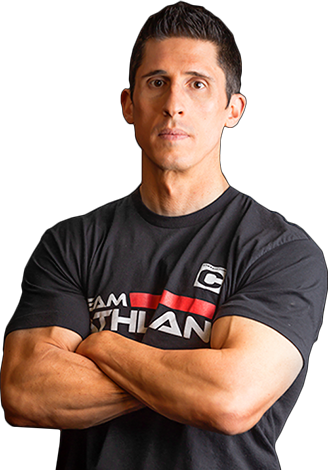
Jeff Cavaliere M.S.P.T, CSCS
Jeff Cavaliere is a Physical Therapist, Strength Coach and creator of the ATHLEAN-X Training Programs and ATHLEAN-Rx Supplements. He has a Masters in Physical Therapy (MSPT) and has worked as Head Physical Therapist for the New York Mets, as well as training many elite professional athletes in Major League Baseball, NFL, MMA and professional wrestling. His programs produce “next level” achievements in muscle size, strength and performance for professional athletes and anyone looking to build a muscular athletic physique.

